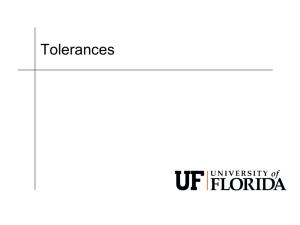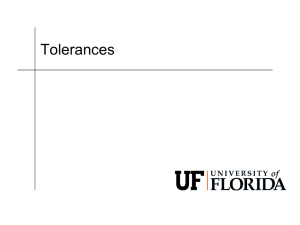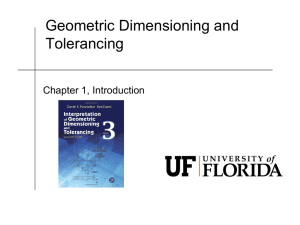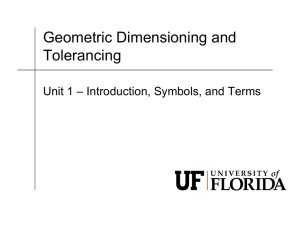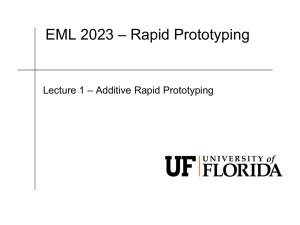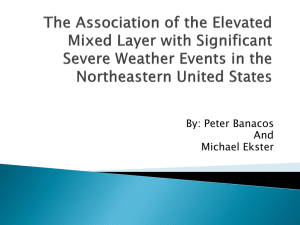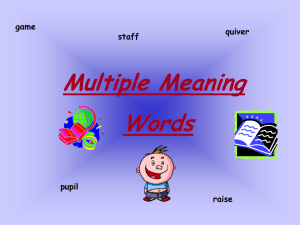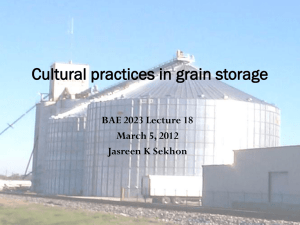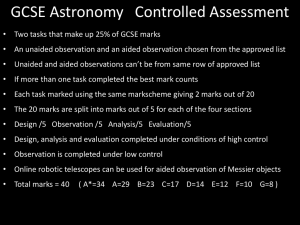Lecture2_clearance_fits
advertisement
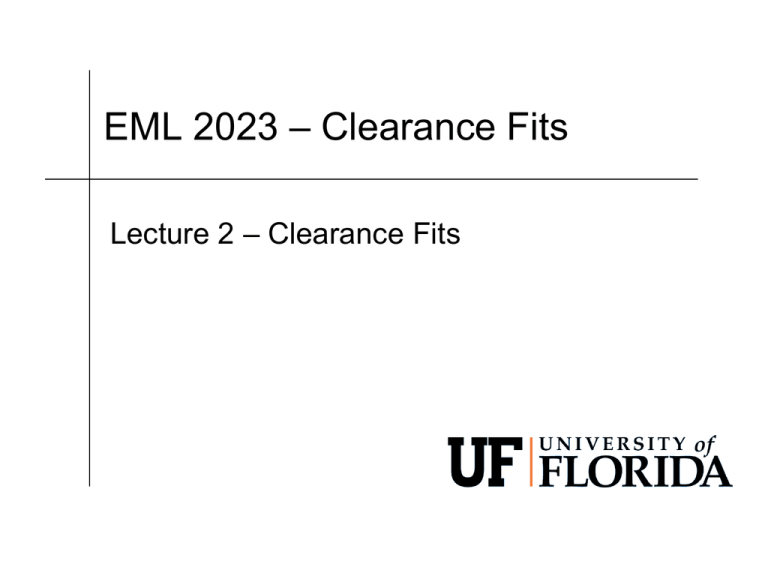
EML 2023 – Clearance Fits Lecture 2 – Clearance Fits Cylindrical Fits EML 2023 Computer Aided Design 2 Cylindrical Fits – English Units EML 2023 Computer Aided Design 3 Cylindrical Fits – English Units EML 2023 Computer Aided Design 4 Cylindrical Fits – English Units EML 2023 Computer Aided Design 5 Cylindrical Fits – English Units EML 2023 Computer Aided Design 6 Cylindrical Fits – English Units tolerance - difference between the limits of size for a single feature ; shaft .0025 ; hole .0040 limits of tolerance – the max and min sizes of a single feature allowance – the tightest fit between two mating parts ; .0050 nominal size – the general size of a shaft or hole ; 1.5 basic size – the size to which the plus-and minus is applied actual size – the measured size of the finished part fit - the degree of tightness or looseness between two assembled parts EML 2023 Computer Aided Design 7 Cylindrical Fits – English Units • clearance fit – gives a clearance between two assembled mated parts ; • min clearance .005 ; • max clearance .0115 • transition fit • interference fit • line fit EML 2023 Computer Aided Design 8 Cylindrical Fits – English Units • clearance fit • interference fit – a binding fit that requires the parts to be forced together, much as if they were welded • transition fit – may range from a interference fit to a clearance fit between the mated parts • line fit – results in surface contact or clearance when limits are reached EML 2023 Computer Aided Design 9 Cylindrical Fits – English Units • The ANSI B4.1 standard defines a series of fits between cylindrical features in inches for the basic hole system. • The types of fits covered in the standard are: – – – – – RC: running or sliding clearance fits LC: clearance locational fits LT: transition locational fits LN: interference locational fits FN: force and shrink fits EML 2023 Computer Aided Design 10 Cylindrical Fits – English Units • RC: running or sliding clearance fits – RC1 to RC9 • LC: clearance locational fits • LC1 to LC11 • LT: transition locational fits • LT1 to LT6 • LN: interference locational fits • LN1 to LN3 • FN: force and shrink fits • FN1 to FN5 EML 2023 Computer Aided Design 11 Example – RC9 Fit • hole and shaft have a basic diameter of 2.5” • From Tables in Appendix 29 thousands of an inch EML 2023 Computer Aided Design 12 Example – LT3 Fit • hole and shaft have a basic diameter of 2.5” • From Tables in Appendix 31 2.5012 2.5000 2.5008 2.5001 thousands of an inch EML 2023 Computer Aided Design 13 Example – LN2 Fit • hole and shaft have a basic diameter of 2.5” • From Tables in Appendix 32 2.5012 2.5000 2.5021 2.5014 thousands of an inch EML 2023 Computer Aided Design 14 Example Problem 15 Cylindrical Fits – Metric Units • ANSI B4.2 standard • basic size – the diameter from which limits are calculated • upper and lower deviation – the difference between the hole or shaft size and the basic size • tolerance - the difference between the maximum and minimum sizes EML 2023 Computer Aided Design 16 Cylindrical Fits – Metric Units EML 2023 Computer Aided Design 17 Cylindrical Fits – Metric Units • fundamental deviation – a letter grade that describes the deviation closest to the basic size • International Tolerance (IT) grade – a series of tolerances that vary with the basic size to provide a uniform level of accuracy within a given grade • there are 18 IT grades: IT01, IT0, IT1, …, IT16 EML 2023 Computer Aided Design 18 Cylindrical Fits – Metric Units • Hole basis – a system of fits based on the minimum hole size as the basic diameter – the fundamental deviation for a hole-basis system is “H” – Appendices 35 and 36 give hole-basis data for tolerances • Shaft basis – a system of fits based on the maximum shaft size as the basic diameter – the fundamental deviation for a hole-basis system is “h” – Appendices 37 and 38 give shaft-basis data for tolerances EML 2023 Computer Aided Design 19 20 Cylindrical Fits – Metric Units EML 2023 Computer Aided Design 21 Cylindrical Fits – Metric Units EML 2023 Computer Aided Design 22 Example 1 • determine the shaft and hole limits for: – – – – hole-basis system a close running fit a basic diameter of 49 mm use a preferred size EML 2023 Computer Aided Design 23 24 Example 1 • use a preferred basic diameter of 50 mm • use a fit of H8/f7 EML 2023 Computer Aided Design 25 Example 2 • determine the shaft and hole limits for: – – – – hole-basis system a location transition fit a basic diameter of 57 mm use a preferred size EML 2023 Computer Aided Design 26 EML 2023 Computer Aided Design 27 Example 2 • use a preferred basic diameter of 60 mm • use a fit of H7/k6 EML 2023 Computer Aided Design 28 Example 3 • determine the shaft and hole limits for: – – – – hole-basis system a medium drive fit a basic diameter of 96 mm use a preferred size EML 2023 Computer Aided Design 29 30 Example 3 • use a preferred basic diameter of 100 mm • use a fit of H7/s6 EML 2023 Computer Aided Design 31 Nonstandard Fits, Nonpreferred Sizes • determine the shaft and hole limits for: – hole-basis system – a close running fit – a basic diameter of 45 mm (do not change to a preferred size) EML 2023 Computer Aided Design 32 33 Nonstandard Fits, Nonpreferred Sizes • use a fit of H8/f7 EML 2023 Computer Aided Design 34
